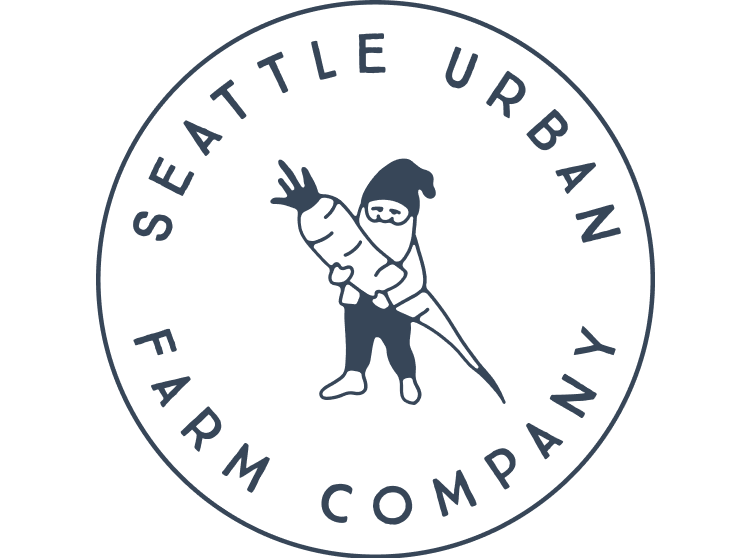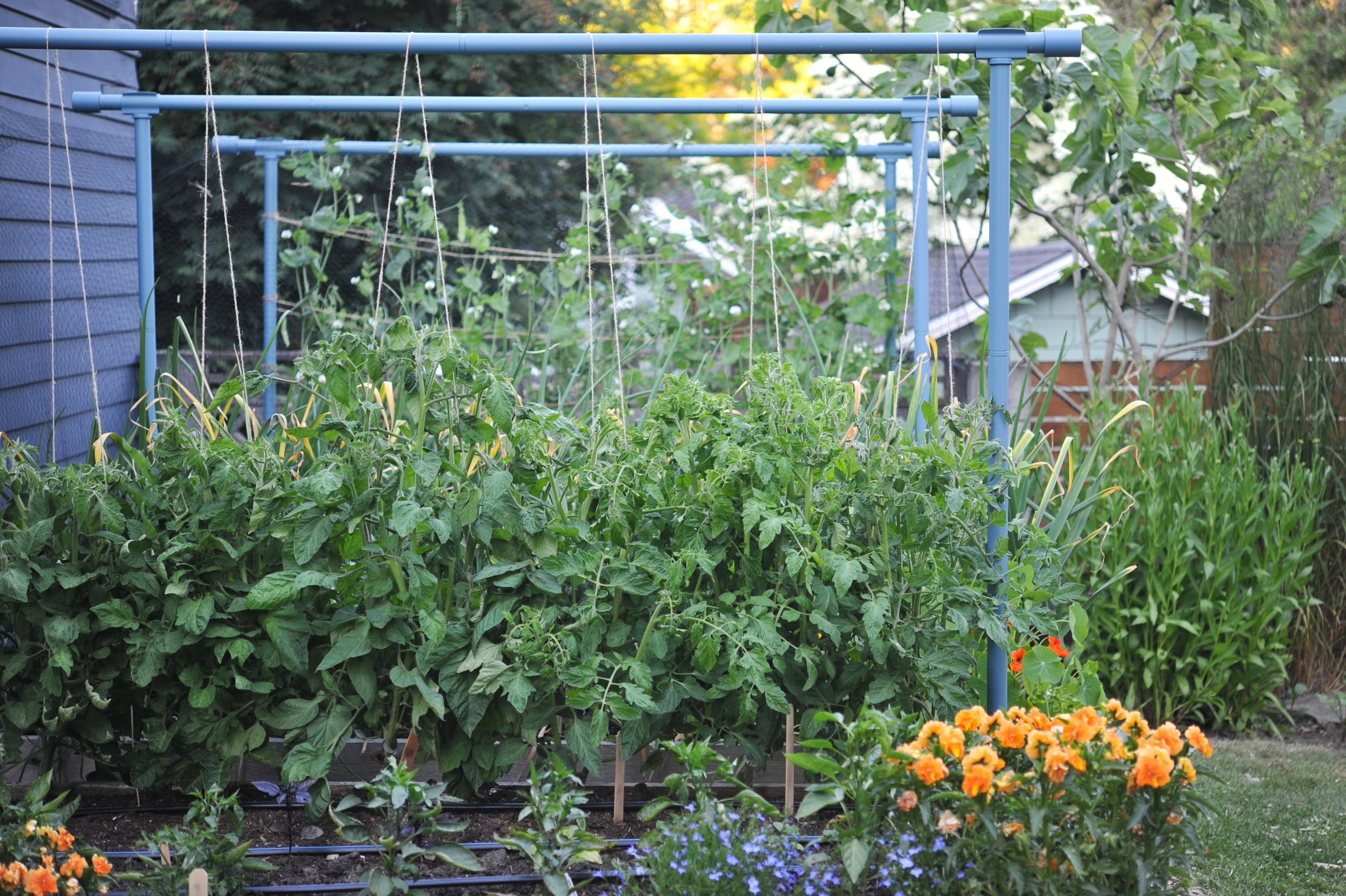The complete garden trellis guide
At Seattle Urban Farm Company, we’ve been thinking about trellises for a long time. We’ve been designing, building, and maintaining edible gardens since 2007. Over the years, we’ve built and cared for hundreds of gardens of all shapes and sizes. For most of that time, we either bought off-the-shelf trellises or custom-built them for our gardens. Trellises make a big impact on the appearance of your garden, the health of your crops, and the quantity of your harvest. Let’s take a look at some of the most commonly asked questions about trellises.
What is a garden trellis?
A garden trellis is a structure that supports plants and keeps them off the ground. Trellises are most commonly used for vining, trailing, and top-heavy plants. Trellises help hold plants in place, for example if you want a vine to grow over the top of a entrance or up along a wall; they also prevent plants from breaking, which can happen to vines with very heavy fruits, like tomatoes; and they can keep plants healthy by improving airflow through and around the plant.
What are the different kinds of garden trellises?
Garden trellises come in hundreds of different materials, sizes, and designs. Some common types of trellises are string trellises, cage trellises, stakes, wire mesh, ladder trellises, and A-frame trellises. The type of trellis you choose may depend on the plant you’re growing and the space you’re growing in. If you’re looking for a one-size-fits all solution, we created the Freyr trellis to be as versatile as possible. The Freyr trellis was designed to support all fruiting crops and flowers, and to fit into a wide range of garden set-ups.
How does a garden trellis work?
Most garden trellises work by creating a structure to support your growing plant. Certain plants have tendrils, which help the plants wrap themselves around the structure and pull themselves up as they grow. Some examples of plants with tendrils are cucumbers, peas, and squash. Other plants don’t have tendrils and so need more help from the gardener to hold onto or grow along the trellis. Examples of plants without tendrils include tomatoes, tomatillos, and peppers.
What is the best garden trellis?
The best garden trellis for you may depend on a few key factors. You may want to consider the size of the trellis. Not all trellises are large enough for all plants, even common tomato cages can be too small for a full-grown tomato plant. You may also consider the lifespan of the trellis. Many trellises are made from thin, uncoated metal that may rust and break after a season or two. Other inexpensive options are made from plastic that may only last a single season. Think about the lifespan of the trellis that you want. Some will last for many seasons and others may need to be replaced every few years. Also, make sure that you consider the strength of the trellis. The last thing you want to do is set up a structure that isn’t strong enough for your full grown plant! These are some of the considerations we had in mind when we designed the Freyr trellis. It’s designed to be the most versatile, durable, beautiful, and sustainable trellis available.
Why is a garden trellis good?
Garden trellises can improve your garden by adding structure, making the site more aesthetically appealing. They can also make your garden more productive, by allowing you to grow more plants vertically rather than horizontally. This allows you to plant more crops in the same amount of space. Trellises provide essential support for many vining, trailing, and top-heavy crops. Plants like tomatoes, peas, and beans grow best when kept off the ground. Trellising improves the airflow to the plant, keeping it healthier longer; it also prevents fruits from rotting, which they do more quickly when in contact with the ground; it also prevents plant stems from breaking under the weight of their fruit set.
What are trellises used for?
Trellises are used to support plants and keep them off the ground. Many plants, especially in the vegetable garden, are susceptible to rot and disease if left to sprawl on the ground. Keeping plants off the ground also prevents critters from getting access to your harvest. In the vegetable garden, trellises are most commonly used for tomatoes, cucumbers, beans, peas, squash, watermelon, and peppers.
How much does a garden trellis cost?
The price of a garden trellis depends on its size and the material it’s made from. Inexpensive options made from plastic or thin metal are available, but may only last a season or two before needing to be replaced. Other types of trellis like tomato cages can range anywhere from $15-80 depending on the size and thickness of the metal. If you’re looking for a long term solution for your garden trellis needs, consider a Freyr trellis. This high-quality trellis made from powder-coated aluminum is made to last and can support a number of crops at the same time. You can learn more about the versatility, durability, appearance, and sustainability of the Freyr trellis on our website.
How many garden trellises do I need?
The number of garden trellises you need will depend on the size of your garden and the number of vining, trailing, and top-heavy plants you plan to grow. Some trellises, like a tomato cage, are designed to support a single plant. If using single-plant trellises, you’ll need one for each plant. Other trellises, like the Freyr trellis, are designed to hold a number of plants at the same time. The exact number of plants will depend on the crop, but as an example, a single Freyr trellis can support six tomato plants. It can also be used to hold several types of crops at the same time, so a single trellis can support both beans and cucumbers at the same time! If you’re using a multi-plant support like the Freyr, you may need one trellis per bed or for every other bed in the garden, depending on your crop choices.
Where do I buy a garden trellis?
Trellises can be purchased at hardware stores, plant nurseries, and online retailers. There are many types of trellises available and each retailer will carry a small selection of those available on the market. The Freyr trellis can be purchased directly online at www.seattleurbanfarmco.com
What plants do you grow on a trellis?
Many annual and perennial plants can be grown on a trellis. Annual plants are those that live for only one growing season and are replanted each year. Examples of annual plants grown on a trellis include: pole beans, tomatoes, cucumbers, summer squash, winter squash, snap peas, shelling peas, and sweet peas. Examples of perennial plants grown on a trellis include: grapes, hops, dahlias, and kiwis.
What’s the most sustainable plant trellis?
The sustainability of a trellis depends on the materials it’s made with and it’s longevity (or how often it needs to be replaced). Bamboo trellises can be a sustainable choice, depending on where and how the bamboo was harvested. The Freyr trellis is made from powder-coated aluminum. Aluminum doesn’t rust, so the Freyr trellis will last pretty much forever. It’ll never need to be replaced, but can be recycled. The Freyr trellis is designed to work with compostable strings made from hemp or jute. This way, there’s no one-time use plastic and all of your plant debris can be easily tossed into the compost at the end of the season.
What is string trellising?
String trellising is a technique used by professional growers all over the world. There are two main types of string trellising: vertical string trellising and horizontal string trellising. In vertical string trellising, the idea is to tie strings onto a strong framework and train your crops to grow directly up the strings. Often, vertical strings are tied to the purloins (horizontal framing) on the inside of a greenhouse. Horizontal string trellising uses strings tied to posts in the ground and the strings are wrapped from one post to another to hold plants in place. We designed the Freyr trellis to offer homeowners a strong, sturdy framework that works perfectly for vertical and horizontal string trellising in any garden (no greenhouse required!)
What do you do with a trellis in the winter?
Trellises can be left in place during the winter or taken down and stored until the next season. What you decide to do may depend on the plants your trellis is supporting. If you’re using a trellis to hold up perennial plants (those that live more than 1 season), you’ll most likely want to keep it in place year-round. However, trellises in the vegetable garden can be more flexible. You definitely want to remove all dead plant debris from your trellis at the end of the season. This makes it look better and removes potential sites for the spreading of plant disease to next year’s crops. Whether you keep up the trellis or take it down may depend on what it’s made of and how good it looks in the garden without plants. Some trellises are designed to look good even without plants, while others may look a little out of place when left by themselves.
What else can you do with a trellis?
While trellises are mainly designed and used to support plants, that doesn’t mean you can’t get creative! In addition to growing plants in the ground, a sturdy trellis can be used for hanging pots, adding a burst of color to the garden. They can also be used to support hanging lights, during the holidays, or all year round. We’ve also seen gardeners adding mason bee boxes, birdhouses, and artwork to trellises.
At Seattle Urban Farm Company, we’re trying to help everyone grow a garden they love. We share pro garden tips and tricks daily on our instagram and are developing new, innovative tools for the home garden. Reach out and say hello, we’d love to talk with you about your garden!




